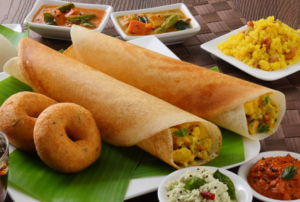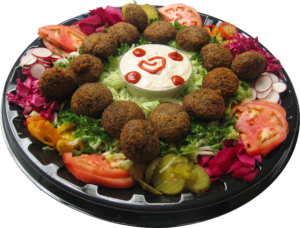ASIAN CUISINE PRESENTATION AT FOOD AND NUTRITION CONFERENCE AND EXPO

By Lucia Rivera, VRG Intern
As part of the 2020 Food & Nutrition Conference & Expo, which is professional education for dietitians, nutrition experts Breana Killeen, Michelle Jaelin, Rahaf Al Bochi, Manju Karkare, and Tessa Nguyen presented an Education Session Spotlight titled “Asian Cuisine: Beyond the Soy Sauce.”
The session focused on nutrition and diet in the five regions of Asia: East, Southeast, Central, South, and West. All five speakers described staples in the respective regions, and gave the audience suggestions for creating regionally informed Asian cuisine recommendations.
Vegetarian and vegan staples like rice, legumes, soy, breads, and vegetables were touched on during the session, in addition to notes on the way religion lessens certain meat-eating in some regions. In South Asia, for example, legumes are often used as a primary source of protein, for both vegetarians and non-vegetarians.
I believe that the information presented can also be applied well to daily life for travelers or for those eating out at any kind of Asian restaurant. For example, vegans can learn to keep an eye out for specific non-vegan ingredients that may be commonly used in different cuisines, such as fish sauce in the Vietnamese cuisine. Contrastingly, it is also useful to know what vegan dishes you can look out for, like the West Asian hummus made primarily from chickpeas.
Breana Killeen specifically spoke to the importance of not just “grouping together” all Asian people and cuisines. One way this can be avoided is through getting adequately familiar with regional Asian cuisine staples and traditions. The presentation first focused on East and Southeast Asia.
The major staples in East Asia are rice and protein, which are used in [non-vegetarian] dishes like South Korean Bibimbap and fried chicken. South Korean dishes also make use of key condiments including yondu and gochujang, which is a soybean and red pepper-based sauce.
Gochujang is one of the ingredients used to create the spicy aspect of some South Korean dishes, in addition to garlic and ginger. For sour flavors, people can make use of plum or apple vinegar. Sweet ingredients commonly used are rice syrup and Asian pears, the latter which can be found in western grocery stores as well.
In Southeast Asia, however, rice and protein staples are used in different ways. In Vietnamese cuisine, for example, rice is often used to make noodles and rice paper for pho and summer rolls, respectively. Vietnamese cuisine also includes the use of chicken, pork, seafood, and soy for protein, whether that be as tofu, soybeans, or another form. Vietnamese condiments also range from soy sauce to Viet huong fish sauce to pork floss.
The ingredients that are used in Vietnamese cuisine to achieve salty, spicy, sweet, sour, and unique flavors also vary from those used in South Asia. For example, salty ingredients commonly used are fish sauce and soy sauce, while for spicy dishes bird’s eye chiles and jalapeños are common in addition to ginger and garlic. Sour limes, lemons, and vinegar are also ingredients used in Vietnamese cuisine (not as often in South Korean dishes), in addition to unique lemongrass, Thai basil, and turmeric. Lastly, in order to sweeten the flavor of some dishes, onions, sweetened condensed milk, and five spice is used often in Vietnam.
Despite their differences, both Vietnamese and South Korean cultures emphasize communal eating and the inclusion of certain flavors and non-vegetarian staples like pork, in their cuisine.
Next in the session, Michelle Jaelin described the staples and common ingredients of Central Asia, which includes China, Mongolia, Tajikistan, Uzbekistan, Kazakhstan, Kyrgyzstan, and Turkmenistan.
In Central Asia, the cuisine varies sharply between China and the countries often referred to as the ‘Stans.’ In Tajikistan, Mongolia, Uzbekistan, Kazakhstan, Kyrgyzstan, and Turkmenistan, some key protein sources are horse meat, Mongolian khorkhog (a traditional barbeque meat dish), kumis (fermented mare milk), suutei tsai (milk tea), and shubat (fermented camel milk). In these countries wheat is also used in a variety of breads, like lepyoshka bread in Kyrgyzstan.
Rice, however, is an important staple throughout all of Central Asia. While white rice is common, plov, or pilaf, also is a dish from the ‘Stans.’ In Mongolia, budaatai khuurga is a rice dish traditionally eaten with meat and vegetables. Rice noodle varieties are also prominent in Central Asian cuisine. When it comes to spices and herbs, chiles are used often in the Sichuan province of China, but Chinese 5 spice, green onion, and garlic are used more widely.
Chinese cuisine also features beef, egg, fish, pork, tofu, seitan, and insect sources for protein. It is important to note, however, that many of these originate from different regions of China. For example, BBQ pork is a traditional Cantonese dish, while tofu is used more often in Sichuan. In Chinese cuisine, you will also not find as much dairy as in the rest of Central Asian food.
In respect to condiments, they are more prevalent in China, where soy sauce, chili oil, hoisin sauce, sesame oil, Shaoxing rice cooking wine, oyster sauce, black bean garlic sauce, rice vinegar, and doubanjiang (bean chili paste) are all used. Specifically to achieve spicy flavors, peppercorns, hot pepper oil, chili paste, cayenne pepper, and more are used. Sweet flavors in Central Asia are achieved with sugar, hoisin sauce, rock sugar (crystallized sugar), dried fruit, and more. Overall, though, less fresh fruit and vegetables are used in the ‘Stans’ than in China.
After discussing Central Asian cuisine, Manju Karkare spoke on South Asian cuisine, which spans across Pakistan, Afghanistan, India, Bangladesh, Sri Lanka, Maldives, Bhutan, and Nepal. The rice staple in South Asia is used through both long grain basmati rice dishes and short grain rice dishes. The former is primarily used on special occasions.
Flatbread is another staple of South Asian food, and can be found in the form of naan in Northern India, Pakistan, and Afghanistan, but also in the form of chapati, puran poli, dosa, poori, and paratha in other regions.
For protein, people in South Asia make use of both plant and animal protein sources. More specifically, chicken, seafood, and mutton are common animal protein, while pork and beef are uncommon due to the religious demographics. Plant proteins include beans, lentils, and sprouted beans, which are eaten by both vegetarians and non-vegetarians. Dairy is consumed in the form of ghee, buffalo milk products, and paneer, in dishes like rasmalai (cream and cheese dumplings).
Additionally, South Asian foods include many nuts, seeds, and dried fruits, in addition to coconut. Coconut is used green, fresh, mature, or as milk. Coconut is one of the sweet ingredients commonly used, in addition to jaggery (unrefined sugar), dates, golden raisins, and dairy cream. Spicy flavors come from the use of chiles, cumin, coriander, cloves, garam masala, ginger, and garlic. Sour flavors can be achieved through the use of tamarind, green mango, yogurt, buttermilk, lemon, and fermented foods as well. Ingredients unique to South Asian and Indian cuisine include saffron, rose, jasmine, turmeric, and cardamom.
When shifting to West Asian cuisine, we can see that there is even more diversity between regional Asian dishes. West Asia includes Georgia, Armenia, Azerbaijan, Turkey, Cyprus, Syria, Lebanon, Israel, Palestine, Jordan, Iraq, Iran, Kuwait, Bahrain, Qatar, Saudi Arabia, Oman, United Arab Emirates, and Yemen. Some of the major staples in West Asian cuisine are legumes; fruits and vegetables; grains; bread; yogurt; animal proteins; and fats, oil, and nuts.
When it comes to legume use, fava beans, chickpeas, kidney beans, and lentils are often used in dishes like soup, falafel, and hummus. Common fruit and vegetable ingredients are olives, radishes, cucumbers, spinach, eggplant, zucchini, peppers and more. An example of a dish that makes use of these ingredients is a yogurt dip with mint, cucumber, radishes, and olives.
Grains eaten in West Asia range from cracked wheat (bulgur) to freekeh, to various kinds of rice. Bread is also used, specifically pita bread, saj bread, and lavash bread.
For protein, yogurt is often used, whether it be as a drink, dip, or within cooked meals. Common animal sources of protein are meat kabobs, shawarma, and fish, but not pork.
Nuts (such as pine nuts, almonds, walnuts, and pistachios) are often roasted, but pistachios are also used fresh. Ghee and extra virgin olive oil are also staples in West Asian cuisine.
Lastly, sumac, cumin, baharat, zaatar, turmeric, saffron, and cardamom are all spices common in West Asia. Tahini, a sesame seed paste, is also used, in addition to pomegranate molasses, which is made from boiled down pomegranate juice.

Overall, all this knowledge can be used to be specific and accurate when preparing, describing, or creating recipes inspired by different parts of Asian cuisine. For example, people should avoid using words like ‘global’ or ‘ethnic’ to describe dishes, and focus on being regionally specific instead of using phrases like ‘Chinese fried rice.’ It is also important not to describe food by comparing it to another staple dish, such as saying something is the Asian version of a taco or hamburger.
Asian cuisine is much more detailed and diverse than sometimes presented, but it is always possible to gain culturally sensitive and accurate knowledge on regional cuisine, and appreciate the differences between those cuisines as well.
For vegan ethnic cuisine recipes, see:
https://www.vrg.org/journal/CookingAndRecipes.htm#cr-ethnic-cuisine
The contents of this posting, our website, and our other publications, including Vegetarian Journal, are not intended to provide personal medical advice. Medical advice should be obtained from a qualified health professional. We often depend on product and ingredient information from company statements. It is impossible to be 100% sure about a statement, info can change, people have different views, and mistakes can be made. Please use your best judgment about whether a product is suitable for you. To be sure, do further research or confirmation on your own.
